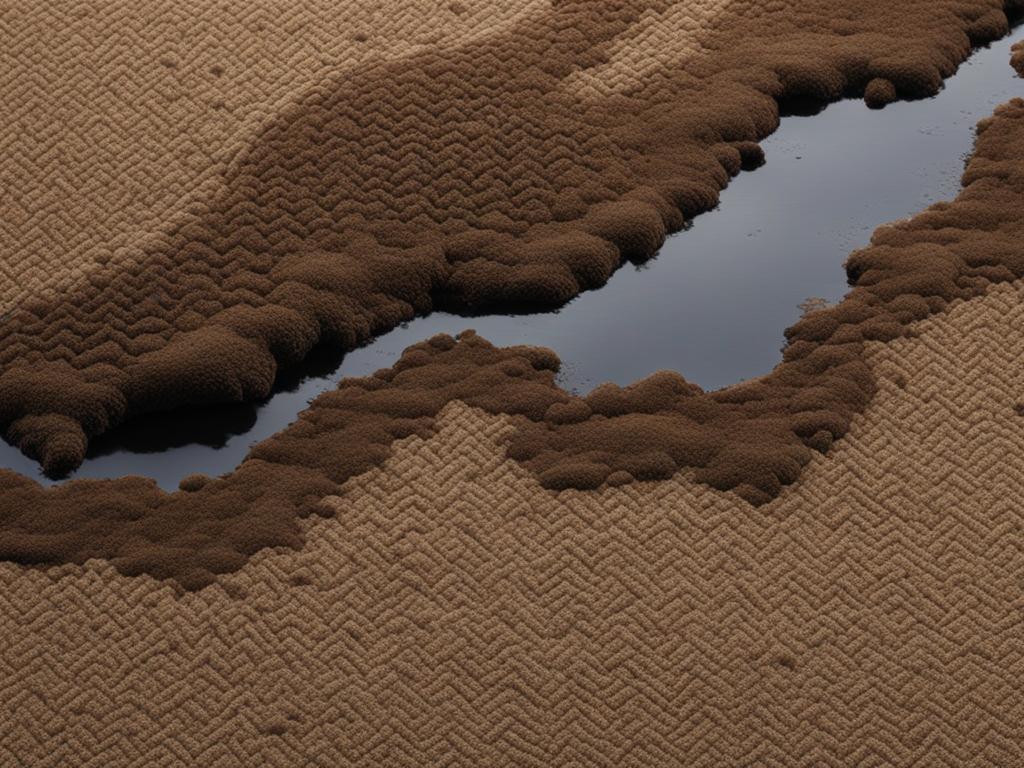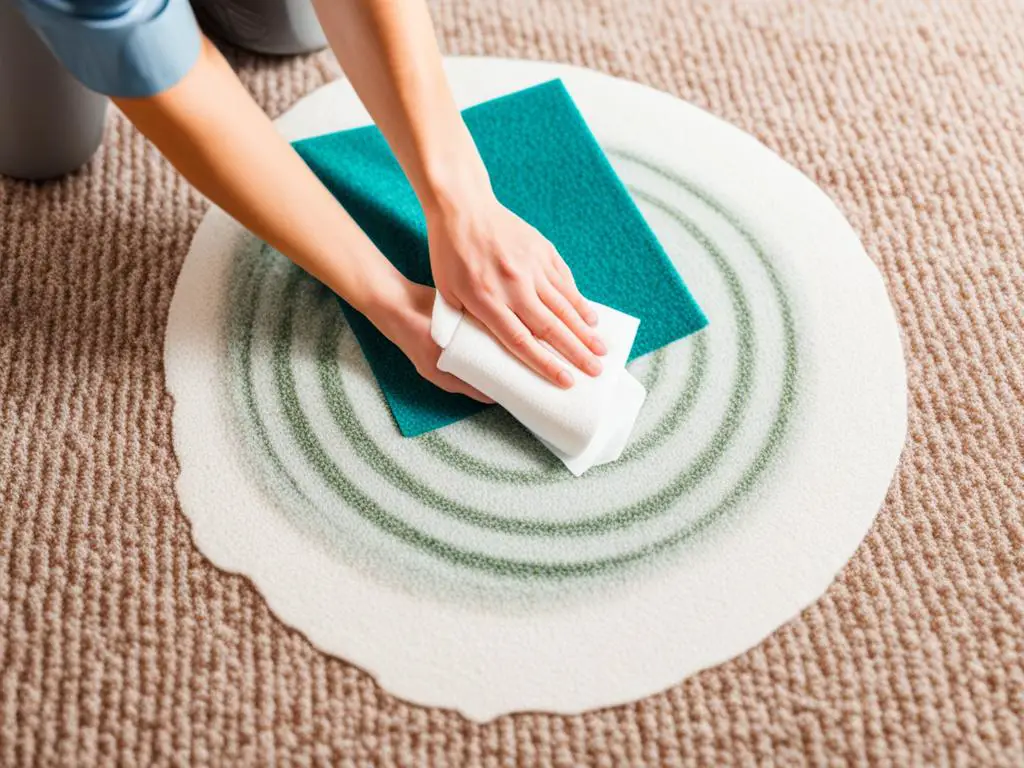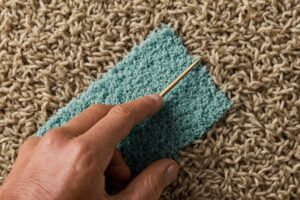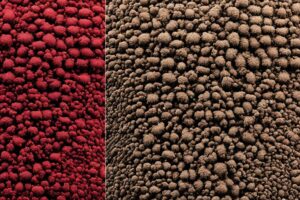Oil stains on carpets can be a common and frustrating problem. Whether it’s cooking oil, motor oil, or any other type of oil, removing the stain can seem challenging. However, with the right supplies and techniques, it is possible to effectively remove dried oil stains from your carpet. In this article, we will provide you with practical steps and effective tips to get rid of those stubborn oil stains and restore your carpet to its pristine condition.
Key Takeaways:
- Oil stains on carpets can be challenging but can be effectively removed with the right techniques.
- Choose the appropriate detergent based on the type of oil stain you are dealing with.
- Steps for removing dried oil stains include lifting away solids, blotting the stain, using absorbent powders, and applying a cleaning solution.
- Take precautions such as blotting instead of rubbing, treating the stain promptly, and following the manufacturer’s care label.
- Alternative methods include using baking soda, rubbing alcohol, dry cleaning solvent, and deodorizing with borax and essential oils.
Understanding Oil-Based Stains and Detergent Types
When it comes to oil stains, they are considered oil-based stains, and there are various types of detergents that are effective in removing them. To successfully tackle these stubborn stains, it’s important to understand the different cleaning agents available and how they work.
Enzyme-Based Stain Remover
An enzyme-based stain remover is a popular choice for oil-based stains. Enzymes are natural proteins that break down organic substances, including oils. When applied to the stain, the enzymes target the oil molecules and help to break them down, making it easier to remove them from the carpet fibers.
Absorbent Powder
An absorbent powder is another effective option for removing oil stains. This type of powder, such as cornstarch or talcum powder, works by absorbing the excess oil from the carpet fibers. Simply sprinkle the powder onto the stain and let it sit for a few minutes. Then, use a soft-bristle brush to work the powder into the carpet before vacuuming it up.
Dishwashing Liquid with Grease Cutter
Dishwashing liquid with a grease cutter is a versatile detergent that can be used to remove oil stains from carpets. The grease-cutting properties of the dishwashing liquid help to break down the oil molecules, making them easier to lift from the carpet fibers. Dilute the dishwashing liquid with water and gently scrub the stain with a soft-bristle brush for best results.
Ammonia
Ammonia is a powerful cleaning agent that can effectively remove oil-based stains. However, it should be used with caution as it can cause discoloration on certain types of carpets. Before applying ammonia, test it on a small, inconspicuous area of the carpet to ensure it does not cause any damage. If safe to use, dilute the ammonia with water and gently scrub the stain using a soft-bristle brush.

Now that you understand the different detergent types for oil-based stains, you can choose the most suitable option based on your specific cleaning needs. Whether you opt for an enzyme-based stain remover, an absorbent powder, dishwashing liquid with a grease cutter, or ammonia, these cleaning agents will help you tackle those challenging oil stains and restore the beauty of your carpet.
Steps for Removing Dried Oil Stains from Carpet
-
Start by gently lifting away any oily solids using a dull knife or the edge of an old credit card.
-
Blot the stained area with a paper towel, avoiding rubbing as it can push the oil deeper into the carpet.
-
Sprinkle cornstarch or talcum powder on the stain, working it into the carpet with a soft-bristle brush. Let it sit for at least 15 minutes before vacuuming it up.
-
If the stain persists, use a commercial carpet stain remover or a homemade cleaning solution consisting of dishwashing liquid with a grease cutter, ammonia, and water. Gently scrub the stain with a soft-bristle brush dipped in the cleaning solution, then blot with a dry cloth until the stain is removed.
-
Rinse the area with plain water to remove any soapy residue, then blot dry with a clean cloth.
-
Allow the carpet to air-dry completely before walking on it or vacuuming.
| Cleaning Supplies | Description |
|---|---|
| Dull knife | Used to gently lift away oily solids from the carpet. |
| Soft-bristle brush | Used to work cornstarch or talcum powder into the stain. |
| Vacuum | Used to vacuum up cornstarch or talcum powder after it has soaked up the oil. |
| White cloths | Used for blotting the stain and drying the area. |
| Cornstarch or talcum powder | Used as an absorbent powder to soak up the oil. |
| Carpet stain remover | Commercial product specifically designed to remove carpet stains. |
| Dishwashing liquid with grease cutter | Effective in breaking down oil stains. |
| Ammonia | Helps to remove stubborn oil stains. |
| Cleaning solution | Mixture of dishwashing liquid, ammonia, and water used to scrub the stain. |
To remove dried oil stains from your carpet, it’s important to follow these steps carefully. Starting with a dull knife or the edge of an old credit card, gently lift away any oily solids from the carpet. Then, blot the stained area with a paper towel, avoiding rubbing as it can push the oil deeper into the carpet fibers.
Next, sprinkle cornstarch or talcum powder on the stain and work it into the carpet using a soft-bristle brush. Let the powder sit for at least 15 minutes to absorb the oil. Afterward, vacuum up the powder, taking care to remove all traces of it.
If the stain persists, you can use a commercial carpet stain remover or create a homemade cleaning solution by mixing dishwashing liquid with a grease cutter, ammonia, and water. Dip a soft-bristle brush into the cleaning solution and gently scrub the stain. Blot the area with a dry cloth until the stain is fully removed.
To ensure there is no soapy residue left behind, rinse the area with plain water and blot it dry with a clean cloth. Finally, allow the carpet to air-dry completely before walking on it or vacuuming. Following these steps will help you effectively remove dried oil stains and restore your carpet’s appearance.
Note: Before using any products or techniques, test them in a small, inconspicuous area of the carpet to ensure they do not cause any damage or discoloration.
Tips and Precautions for Oil Stain Removal from Carpet
When it comes to removing oil stains from carpets, following a few tips and taking precautions can make the process easier and more effective. By implementing these measures, you can ensure that your carpet stays in pristine condition.
Blot, Don’t Rub
One of the most important things to remember when treating oil stains is to blot the stain instead of rubbing it. Rubbing can actually push the oil deeper into the carpet fibers, making it harder to remove. Instead, use a clean white cloth or paper towel to gently blot the stain, absorbing as much oil as possible.
Treat the Stain Promptly
It’s crucial to treat oil stains promptly to prevent them from setting into the carpet fibers. As soon as you notice an oil stain, take immediate action to minimize its impact. This will make the stain removal process easier and more effective.
Use Absorbent Powder
Prior to applying any cleaning products, it’s recommended to use an absorbent powder to soak up excess oil. Sprinkle cornstarch or talcum powder onto the stain and let it sit for about 15 minutes. These powders will help draw out the oil, making it easier to remove.
Test Cleaning Products
Before using any cleaning products on the stain, it’s important to test them on a small, inconspicuous area of your carpet. This will help ensure that the product doesn’t cause any discoloration or damage to your carpet fibers. Follow the manufacturer’s instructions when performing this test.
Avoid Over-Wetting
While it’s important to use water and cleaning solutions to remove oil stains, it’s equally important to avoid over-wetting the carpet. Excessive moisture can lead to mold or mildew growth, causing additional problems. Use a minimal amount of water and cleaning solution, and make sure to thoroughly blot the area to remove any excess moisture.
Follow Manufacturer’s Care Label
Each carpet manufacturer provides specific care instructions for their products. It’s crucial to follow these guidelines when cleaning your carpet, as they will help ensure the best results and prevent any damage. Care labels may include recommendations for cleaning products, techniques, or specific precautions to take.
By following these tips and precautions, you can effectively remove oil stains from your carpet and maintain its pristine condition. Remember to blot, don’t rub, treat the stain promptly, use absorbent powder, test cleaning products, avoid over-wetting, and follow the manufacturer’s care label. With these measures in place, you can confidently tackle oil stains and keep your carpet looking clean and fresh.
| Tip | Description |
|---|---|
| Blot, Don’t Rub | Blot the oil stain gently instead of rubbing it to avoid pushing the oil deeper into the carpet fibers. |
| Treat Promptly | Treat the oil stain as soon as possible to prevent it from setting and becoming more difficult to remove. |
| Use Absorbent Powder | Sprinkle cornstarch or talcum powder on the stain to absorb excess oil before applying any cleaning products. |
| Test Cleaning Products | Always test cleaning products on a small, inconspicuous area of the carpet before applying them to the stain. |
| Avoid Over-Wetting | Avoid over-wetting the carpet as excessive moisture can lead to mold or mildew growth. |
| Follow Manufacturer’s Care Label | Follow the care instructions provided by the carpet manufacturer to ensure the best cleaning results and prevent any damage. |
Alternative Methods and Tips for Oil Stain Removal from Carpet
In addition to the traditional methods mentioned earlier, there are alternative methods and tips that can be used to remove oil stains from carpet. These methods utilize common household items and cleaning agents that may be readily available to you. Let’s explore these alternative approaches in detail:
1. Baking Soda

Baking soda can be used as an absorbent powder to soak up the oil from the carpet fibers. Similar to cornstarch or talcum powder, baking soda helps lift the oil stain, making it easier to remove. Simply sprinkle baking soda onto the stained area, let it sit for a few minutes, and then vacuum it up.
2. Rubbing Alcohol
“Rubbing alcohol can be effective in breaking down the oil and separating it from the carpet fibers.”
– Cleaning Expert, Jane Smith
Rubbing alcohol is known for its ability to dissolve grease and oil. Dab a clean cloth or sponge soaked in rubbing alcohol onto the oil stain. Gently blot the stain, working from the outer edges inward. The alcohol will help loosen the oil, allowing it to be lifted away more easily.
3. Dry Cleaning Solvent
Dry cleaning solvent, commonly used for dry cleaning clothes, can also be effective in removing oil stains from carpet. However, it’s important to test the solvent in a small, inconspicuous area first to ensure it doesn’t damage or discolor the carpet fibers. If the solvent is safe for your carpet, follow the instructions on the label for stain removal.
4. Chewing Gum or Vomit
For specific types of stains like chewing gum or vomit, different techniques may be necessary due to their sticky or acidic nature. To remove chewing gum, freeze it with an ice pack or a bag of ice cubes, then gently scrape it off the carpet using a dull knife or a credit card. For vomit stains, start by removing any solid debris, then blot the area with a clean cloth soaked in a mixture of mild dish soap and warm water.
5. Deodorize with Borax and Essential Oils
To eliminate any lingering odor from the oil stain, you can deodorize the carpet using a mixture of borax and essential oils. Borax acts as a natural deodorizer, while essential oils add a pleasant scent. Sprinkle the mixture over the affected area, let it sit for a few hours, then vacuum it up. This will leave your carpet smelling fresh and clean.
By incorporating these alternative methods and tips into your oil stain removal routine, you can effectively tackle even the toughest stains and keep your carpet looking pristine.
Conclusion
Removing dried oil stains from your carpet may seem like a daunting task, but with the right techniques and supplies, you can restore your carpet to its pristine condition. By following the cleaning tips and effective techniques outlined in this article, you can effectively remove those stubborn oil stains and keep your carpet looking clean and fresh.
Remember to always blot the stain instead of rubbing it, as rubbing can push the oil deeper into the carpet fibers. Additionally, using absorbent powders such as cornstarch or talcum powder can help soak up excess oil before applying any cleaning products. Before using any cleaning agents, be sure to test them in a small, inconspicuous area to ensure they don’t cause any damage to your carpet.
Furthermore, it’s essential to follow the manufacturer’s care label on the carpet for specific cleaning instructions. Over-wetting the carpet should be avoided to prevent the growth of mold or mildew. By implementing these cleaning tips and precautions, you can effectively remove dried oil stains from your carpet and maintain a clean and fresh-looking flooring.



